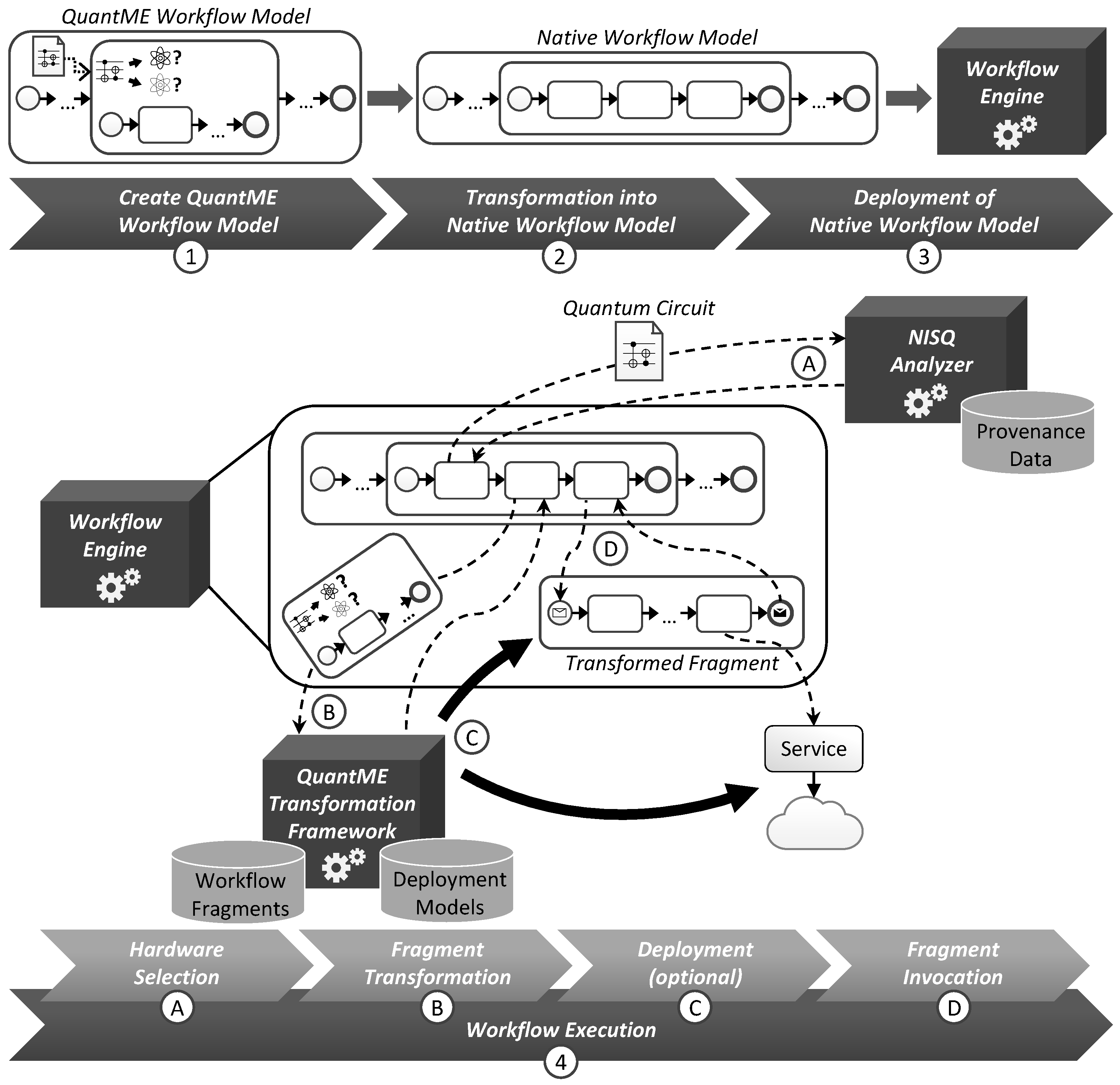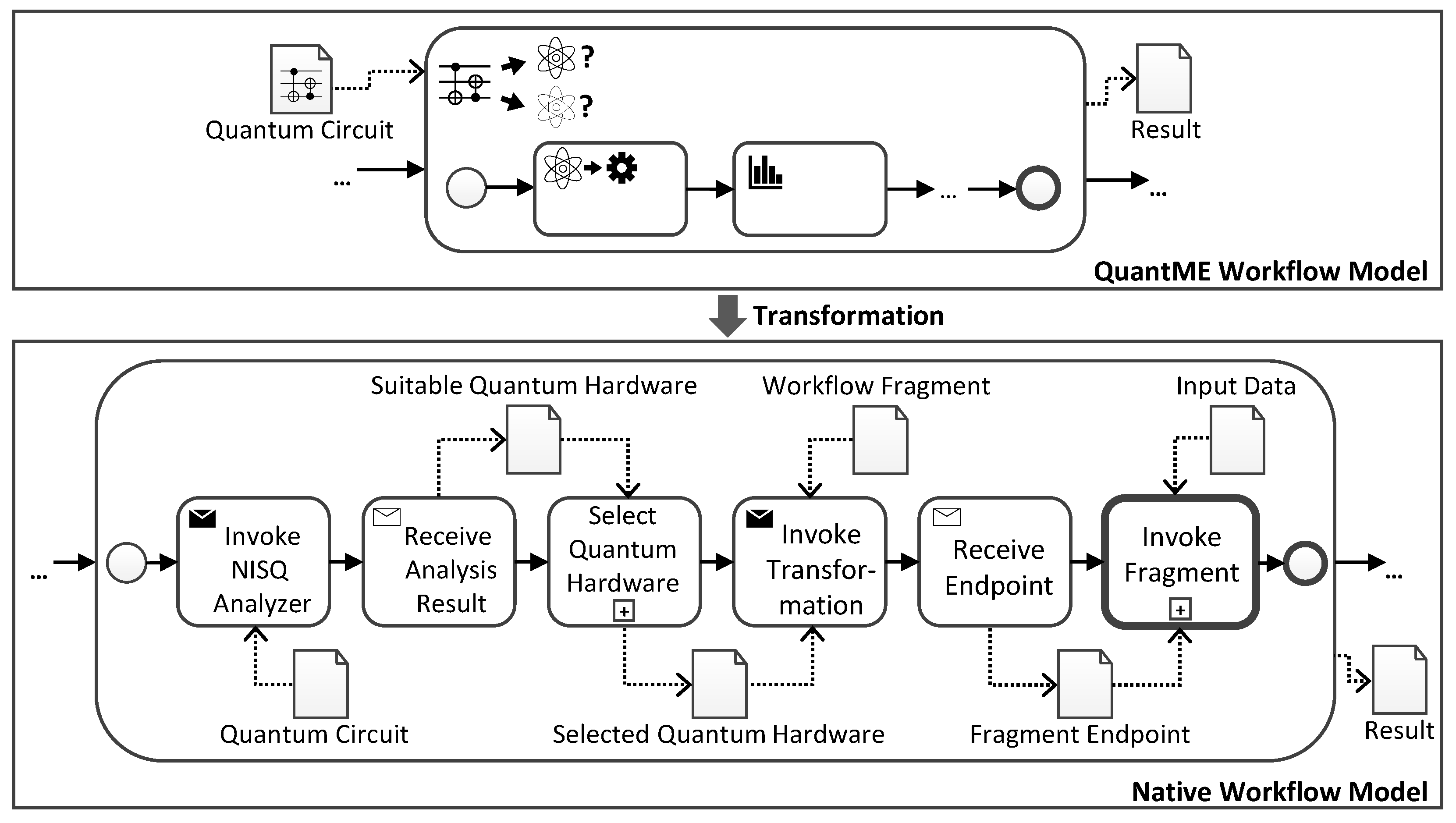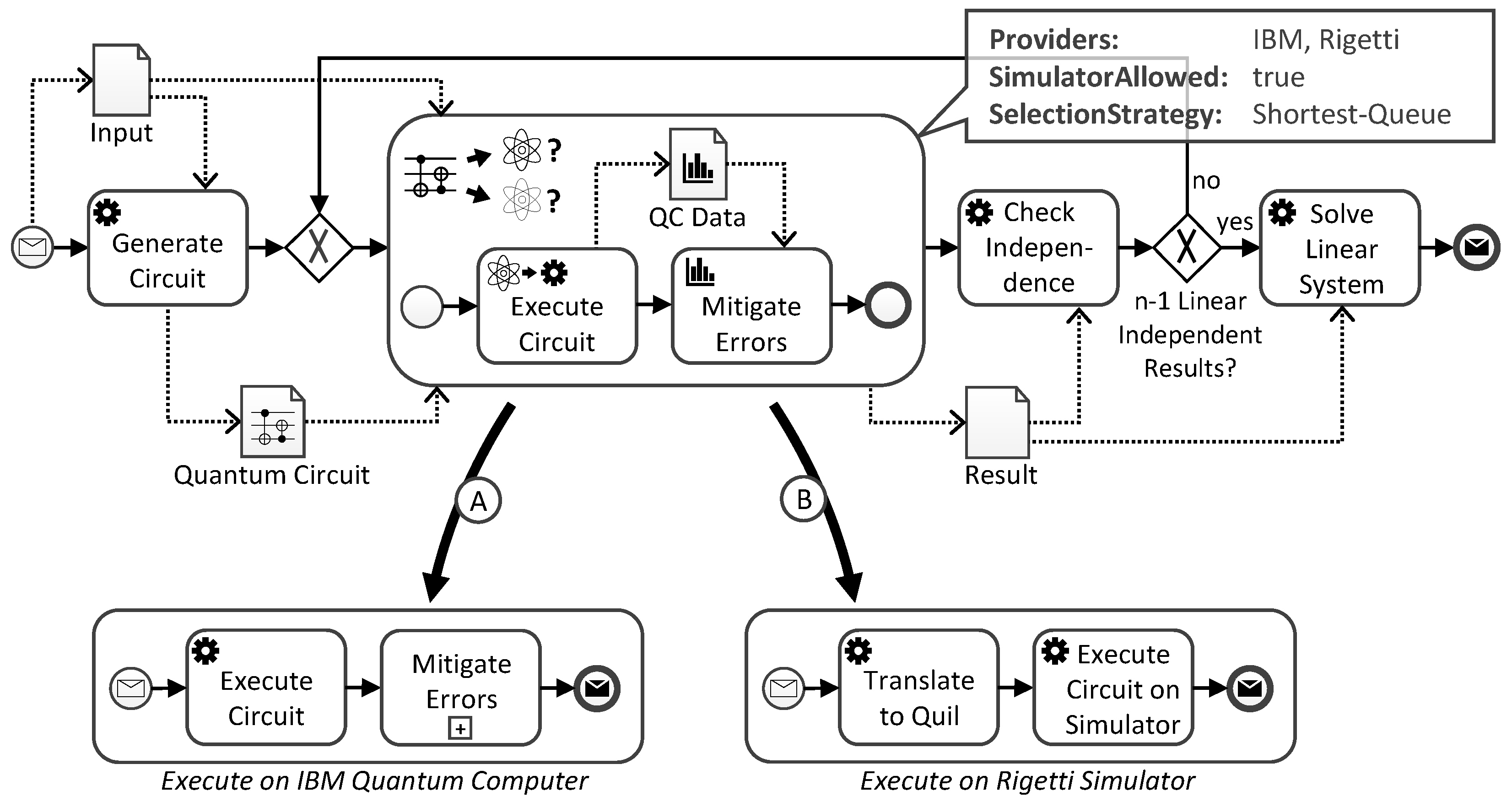Automated Quantum Hardware Selection for Quantum Workflows
Abstract
1. Introduction
2. Fundamentals & Problem Statement
2.1. NISQ Era & Quantum Hardware Selection
2.2. Quantum Workflows & QuantME
2.3. Problem Statement
3. Related Work
4. Automated Quantum Hardware Selection Approach
4.1. Quantum Hardware Selection Subprocess
4.2. Automated Hardware Selection and Dynamic Workflow Adaptation
4.3. Transformation into Native Workflow Models
- First, the NISQ Analyzer is invoked with the ingoing quantum circuit from the Quantum Hardware Selection Subprocess, which is stored in a traditional data object after the transformation.
- Afterward, the result from the NISQ Analyzer is received, and the list of suitable quantum hardware is added to a new data object.
- Next, one of the suitable quantum computers or simulators has to be chosen depending on the selection strategy defined in the configuration attributes of the subprocess. Thereby, the implementation of this activity can, e.g., be done using a script task if the quantum hardware with the shortest queue size should be used. Another selection strategy could include a manual selection and, thus, would be implemented by a human task. Hence, new selection strategies can be added as plugins with the corresponding implementation of the selection task. For this, the implementation of the selection activity is defined as a workflow fragment. These workflow fragments are then automatically injected during transformation based on the configured selection strategy.
- Subsequently, the transformation of the workflow fragment specified within the Quantum Hardware Selection Subprocess has to be performed. For this, the selected quantum hardware, as well as the workflow fragment to transform, are sent to the QuantME Transformation Framework. Thereby, the workflow fragment is serialized and stored in a separate data object, which can, e.g., be done using the XML syntax for BPMN [22]. The result of the transformation is a workflow model, which is assembled from multiple workflow fragments, depending on the QuantME tasks within the subprocess [21].
- The transformed workflow model is deployed after the successful transformation, and the corresponding endpoint is received by the workflow.
- In the last step, the deployed workflow model is invoked with the input data. Thereby, the input data comprises any ingoing data object to the replaced Quantum Hardware Selection Subprocess including the quantum circuit to execute. Finally, the result of the invocation is stored in the data object outside the subprocess, which can be accessed by subsequent tasks in the workflow. The invocation of the transformed workflow fragment is done using a call activity in BPMN. However, if such an activity is not supported by the used workflow language, then it can be split into a send and receive task, as shown for the invocation of the NISQ Analyzer.
5. System Architecture & Prototypical Validation
5.1. System Architecture
5.2. Prototypical Implementation
5.3. Case Study
- First, the calibration matrix for the mitigation is requested from a provenance system, such as QProv (see Section 5.1). Thereby, the calibration matrix differs for various quantum computers and, thus, it depends on the hardware selection [16].
- Afterward, the response from the provenance system is received, containing the calibration matrix for the quantum computer if available. Hence, it does not have to be separately determined for the current workflow execution, reducing the number of quantum circuits to execute and increasing the efficiency [8].
- However, if no up-to-date calibration matrix is available for the selected quantum computer, it can also be directly calculated in the workflow. For this, the corresponding calibration circuits are generated in the next task.
- Subsequently, the calibration circuits are executed on the quantum computer.
- Based on the results from the calibration circuit executions, the calibration matrix can be determined and is stored in a designated data object.
- Finally, the received or calculated calibration matrix is used to mitigate the readout-errors in the execution results that are passed to the subprocess as input. Thereby, different readout-error mitigation or unfolding techniques are available [71,72], and in our example, the so-called matrix inversion technique is used. Hence, the calibration matrix is inverted and multiplied with the execution results to retrieve mitigated results.
6. Conclusions and Future Work
Author Contributions
Funding
Acknowledgments
Conflicts of Interest
References
- Acín, A.; Bloch, I.; Buhrman, H.; Calarco, T.; Eichler, C.; Eisert, J.; Esteve, D.; Gisin, N.; Glaser, S.J.; Jelezko, F.; et al. The quantum technologies roadmap: A European community view. New J. Phys. 2018, 20, 080201. [Google Scholar] [CrossRef]
- LaRose, R. Overview and Comparison of Gate Level Quantum Software Platforms. Quantum 2019, 3, 130. [Google Scholar] [CrossRef]
- Leymann, F.; Barzen, J.; Falkenthal, M.; Vietz, D.; Weder, B.; Wild, K. Quantum in the Cloud: Application Potentials and Research Opportunities. In Proceedings of the 10th International Conference on Cloud Computing and Services Science (CLOSER). SciTePress, Prague, Czech Republic, 7–9 May 2020; pp. 9–24. [Google Scholar] [CrossRef]
- Arute, F.; Arya, K.; Babbush, R.; Bacon, D.; Bardin, J.C.; Barends, R.; Boixo, S.; Brandao, F.G.S.L.; Buell, D.A.; Martinis, J.M.; et al. Quantum supremacy using a programmable superconducting processor. Nature 2019, 574, 505–510. [Google Scholar] [CrossRef] [PubMed]
- Zhong, H.S.; Wang, H.; Deng, Y.H.; Chen, M.C.; Peng, L.C.; Luo, Y.H.; Qin, J.; Wu, D.; Ding, X.; Hu, Y.; et al. Quantum computational advantage using photons. Science 2020, 370, 1460–1463. [Google Scholar] [CrossRef]
- Biamonte, J.; Wittek, P.; Pancotti, N.; Rebentrost, P.; Wiebe, N.; Lloyd, S. Quantum machine learning. Nature 2017, 549, 195–202. [Google Scholar] [CrossRef]
- National Academies of Sciences, Engineering, and Medicine. Quantum Computing: Progress and Prospects; National Academies Press: Washington, DC, USA, 2019. [Google Scholar]
- Leymann, F.; Barzen, J. The bitter truth about gate-based quantum algorithms in the NISQ era. Quantum Sci. Technol. 2020, 5, 044007. [Google Scholar] [CrossRef]
- Preskill, J. Quantum Computing in the NISQ era and beyond. Quantum 2018, 2, 79. [Google Scholar] [CrossRef]
- Salm, M.; Barzen, J.; Breitenbücher, U.; Leymann, F.; Weder, B.; Wild, K. The NISQ Analyzer: Automating the Selection of Quantum Computers for Quantum Algorithms. In Proceedings of the 14th Symposium and Summer School on Service-Oriented Computing (SummerSOC), Crete, Greece, 13–19 September 2020; Springer: Berlin, Germany, 2020; pp. 66–85. [Google Scholar] [CrossRef]
- Salm, M.; Barzen, J.; Leymann, F.; Weder, B. About a Criterion of Successfully Executing a Circuit in the NISQ Era: What wd≪1/ϵeff Really Means. In Proceedings of the 1st ACM SIGSOFT International Workshop on Architectures and Paradigms for Engineering Quantum Software (APEQS), ACM, Virtual, New York, NY, USA, 9 November 2020; pp. 10–13. [Google Scholar] [CrossRef]
- Shor, P.W. Polynomial-Time Algorithms for Prime Factorization and Discrete Logarithms on a Quantum Computer. SIAM J. Comput. 1997, 26, 1484–1509. [Google Scholar] [CrossRef]
- Tannu, S.S.; Qureshi, M.K. Not All Qubits Are Created Equal: A Case for Variability-Aware Policies for NISQ-Era Quantum Computers. In Proceedings of the 24th International Conference on Architectural Support for Programming Languages and Operating Systems (ASPLOS), ACM, Providence, RI, USA, 13–17 April 2019; pp. 987–999. [Google Scholar] [CrossRef]
- Vietz, D.; Barzen, J.; Leymann, F.; Wild, K. On Decision Support for Quantum Application Developers: Categorization, Comparison, and Analysis of Existing Technologies. In Proceedings of the 21st International Conference on Computational Science (ICCS), Krakow, Poland, 16–18 June 2021; Springer: Berlin, Germany, 2021. [Google Scholar]
- Simon, D.R. On the Power of Quantum Computation. SIAM J. Comput. 1997, 26, 1474–1483. [Google Scholar] [CrossRef]
- Maciejewski, F.B.; Zimborás, Z.; Oszmaniec, M. Mitigation of readout noise in near-term quantum devices by classical post-processing based on detector tomography. Quantum 2020, 4, 257. [Google Scholar] [CrossRef]
- Weder, B.; Barzen, J.; Leymann, F.; Salm, M.; Vietz, D. The Quantum Software Lifecycle. In Proceedings of the 1st ACM SIGSOFT International Workshop on Architectures and Paradigms for Engineering Quantum Software (APEQS), ACM, Virtual, New York, NY, USA, 9 November 2020; pp. 2–9. [Google Scholar] [CrossRef]
- Leymann, F.; Roller, D. Production Workflow: Concepts and Techniques; Prentice Hall PTR: Hoboken, NJ, USA, 2000. [Google Scholar]
- Ellis, C.A. Workflow Technology. Comput. Support. Coop. Work Trends Softw. Ser. 1999, 7, 29–54. [Google Scholar]
- Leymann, F.; Karastoyanova, D.; Papazoglou, M.P. Business Process Management Standards. In Handbook on Business Process Management 1; Springer: Berlin, Germany, 2010; pp. 513–542. [Google Scholar] [CrossRef]
- Weder, B.; Breitenbücher, U.; Leymann, F.; Wild, K. Integrating Quantum Computing into Workflow Modeling and Execution. In Proceedings of the 13th IEEE/ACM International Conference on Utility and Cloud Computing (UCC), Leicester, UK, 7–10 December 2020; pp. 279–291. [Google Scholar] [CrossRef]
- OMG. Business Process Model and Notation (BPMN) Version 2.0; Object Management Group: Needham, MA, USA, 2011. [Google Scholar]
- OASIS. Web Services Business Process Execution Language (WS-BPEL) Version 2.0; Organization for the Advancement of Structured Information Standards: Burlington, MA, USA, 2007. [Google Scholar]
- Zhao, J. Quantum Software Engineering: Landscapes and Horizons. arXiv 2020, arXiv:2007.07047. [Google Scholar]
- Nielsen, M.A.; Chuang, I. Quantum Computation and Quantum Information; Cambridge University Press: Cambridge, UK, 2010. [Google Scholar]
- Heyfron, L.E.; Campbell, E.T. An efficient quantum compiler that reduces T count. Quantum Sci. Technol. 2018, 4, 015004. [Google Scholar] [CrossRef]
- Khatri, S.; LaRose, R.; Poremba, A.; Cincio, L.; Sornborger, A.T.; Coles, P.J. Quantum-assisted quantum compiling. Quantum 2019, 3, 140. [Google Scholar] [CrossRef]
- Sivarajah, S.; Dilkes, S.; Cowtan, A.; Simmons, W.; Edgington, A.; Duncan, R. t|ket〉: A Retargetable Compiler for NISQ Devices. Quantum Sci. Technol. 2020. [Google Scholar] [CrossRef]
- Benedetti, M.; Garcia-Pintos, D.; Perdomo, O.; Leyton-Ortega, V.; Nam, Y.; Perdomo-Ortiz, A. A generative modeling approach for benchmarking and training shallow quantum circuits. NPJ Quantum Inf. 2019, 5, 1–9. [Google Scholar] [CrossRef]
- Knill, E.; Laflamme, R.; Martinez, R.; Negrevergne, C. Benchmarking Quantum Computers: The Five-Qubit Error Correcting Code. Phys. Rev. Lett. 2001, 86, 5811–5814. [Google Scholar] [CrossRef] [PubMed]
- Sete, E.A.; Zeng, W.J.; Rigetti, C.T. A Functional Architecture for Scalable Quantum Computing. In Proceedings of the IEEE International Conference on Rebooting Computing, San Diego, CA, USA, 17–19 October 2016; pp. 1–6. [Google Scholar] [CrossRef]
- Bishop, L.; Bravyi, S.; Cross, A.; Gambetta, J.; Smolin, J. Quantum Volume Technical Report. 2017. Available online: http://book.itep.ru/depository/quant_comp/quant_volume.pdf (accessed on 19 April 2021).
- Herschel, M.; Diestelkämper, R.; Ben Lahmar, H. A Survey on Provenance: What for? What Form? What from? VLDB J. 2017, 26, 881–906. [Google Scholar] [CrossRef]
- Cortese, J.A.; Braje, T.M. Loading Classical Data into a Quantum Computer. arXiv 2018, arXiv:1807.02500. [Google Scholar]
- Kandala, A.; Mezzacapo, A.; Temme, K.; Takita, M.; Brink, M.; Chow, J.M.; Gambetta, J.M. Hardware-efficient variational quantum eigensolver for small molecules and quantum magnets. Nature 2017, 549, 242–246. [Google Scholar] [CrossRef]
- Farhi, E.; Goldstone, J.; Gutmann, S. A Quantum Approximate Optimization Algorithm. arXiv 2014, arXiv:1411.4028. [Google Scholar]
- McClean, J.R.; Romero, J.; Babbush, R.; Aspuru-Guzik, A. The theory of variational hybrid quantum-classical algorithms. New J. Phys. 2016, 18, 023023. [Google Scholar] [CrossRef]
- Leymann, F.; Roller, D.; Schmidt, M. Web services and business process management. IBM Syst. J. 2002, 41, 198–211. [Google Scholar] [CrossRef]
- Greenfield, P.; Fekete, A.; Jang, J.; Kuo, D. Compensation is Not Enough. In Proceedings of the 7th IEEE International Enterprise Distributed Object Computing Conference (EDOC), Brisbane, QLD, Australia, 19 September 2003; pp. 232–239. [Google Scholar] [CrossRef]
- Weder, B.; Breitenbücher, U.; Képes, K.; Leymann, F.; Zimmermann, M. Deployable Self-contained Workflow Models. In Proceedings of the 8th European Conference on Service-Oriented and Cloud Computing (ESOCC), Crete, Greece, 28–30 September 2020; Springer: Berlin, Germany, 2020; pp. 85–96. [Google Scholar] [CrossRef]
- Eder, J.; Liebhart, W. Workflow Recovery. In Proceedings of the First International Conference on Cooperative Information Systems (IFCIS), Brussels, Belgium, 19–21 June 1996; pp. 124–134. [Google Scholar] [CrossRef]
- Eberle, H.; Unger, T.; Leymann, F. Process Fragments. In On the Move to Meaningful Internet Systems (OTM); Springer: Berlin, Germany, 2009; pp. 398–405. [Google Scholar] [CrossRef]
- Breitenbücher, U.; Binz, T.; Képes, K.; Kopp, O.; Leymann, F.; Wettinger, J. Combining Declarative and Imperative Cloud Application Provisioning based on TOSCA. In Proceedings of the International Conference on Cloud Engineering (IC2E), Boston, MA, USA, 11–14 March 2014; pp. 87–96. [Google Scholar] [CrossRef]
- Mundbrod, N.; Grambow, G.; Kolb, J.; Reichert, M. Context-Aware Process Injection: Enhancing Process Flexibility by Late Extension of Process Instances. In On the Move to Meaningful Internet Systems (OTM); Springer: Berlin, Germany, 2015; pp. 127–145. [Google Scholar] [CrossRef]
- Bucchiarone, A.; Marconi, A.; Pistore, M.; Raik, H. Dynamic Adaptation of Fragment-based and Context-aware Business Processes. In Proceedings of the 19th International Conference on Web Services (ICWS), Honolulu, HI, USA, 24–29 June 2012; pp. 33–41. [Google Scholar] [CrossRef]
- Képes, K.; Breitenbücher, U.; Sáez, S.G.; Guth, J.; Leymann, F.; Wieland, M. Situation-Aware Execution and Dynamic Adaptation of Traditional Workflow Models. In Proceedings of the 5th European Conference on Service-Oriented and Cloud Computing (ESOCC), Vienna, Austria, 5–7 September 2016; Springer: Berlin, Germany, 2016; pp. 69–83. [Google Scholar] [CrossRef]
- Müller, R.; Greiner, U.; Rahm, E. AgentWork: A workflow system supporting rule-based workflow adaptation. Data Knowl. Eng. 2004, 51, 223–256. [Google Scholar] [CrossRef]
- Rinderle-Ma, S.; Reichert, M. Advanced Migration Strategies for Adaptive Process Management Systems. In Proceedings of the 12th IEEE Conference on Commerce and Enterprise Computing, Shanghai, China, 10–12 November 2010; pp. 56–63. [Google Scholar] [CrossRef]
- Dadam, P.; Reichert, M. The ADEPT project: A decade of research and development for robust and flexible process support. Comput. Sci. Res. Dev. 2009, 23, 81–97. [Google Scholar] [CrossRef]
- Garofalakis, J.; Panagis, Y.; Sakkopoulos, E.; Tsakalidis, A. Contemporary Web Service Discovery Mechanisms. J. Web Eng. 2006, 5, 265–290. [Google Scholar]
- Schonenberg, H.; Mans, R.; Russell, N.; Mulyar, N.; van der Aalst, W. Process Flexibility: A Survey of Contemporary Approaches. In Advances in Enterprise Engineering I; Springer: Berlin, Germany, 2008; pp. 16–30. [Google Scholar] [CrossRef]
- Qasha, R.; Cala, J.; Watson, P. Towards Automated Workflow Deployment in the Cloud using TOSCA. In Proceedings of the 8th International Conference on Cloud Computing (CLOUD), New York, NY, USA, 27 June–2 July 2015; pp. 1037–1040. [Google Scholar] [CrossRef]
- Dörnemann, T.; Juhnke, E.; Freisleben, B. On-Demand Resource Provisioning for BPEL Workflows Using Amazon’s Elastic Compute Cloud. In Proceedings of the 9th IEEE/ACM International Symposium on Cluster Computing and the Grid, Shanghai, China, 18–21 May 2009; pp. 140–147. [Google Scholar] [CrossRef]
- Vukojevic-Haupt, K.; Karastoyanova, D.; Leymann, F. On-demand Provisioning of Infrastructure, Middleware and Services for Simulation Workflows. In Proceedings of the 6th International Conference on Service Oriented Computing and Applications (ICSOC), Koloa, HI, USA, 16–18 December 2013; pp. 91–98. [Google Scholar] [CrossRef]
- Suchara, M.; Kubiatowicz, J.; Faruque, A.; Chong, F.T.; Lai, C.Y.; Paz, G. QuRE: The Quantum Resource Estimator Toolbox. In Proceedings of the 31st International Conference on Computer Design (ICCD), Asheville, NC, USA, 6–9 October 2013; pp. 419–426. [Google Scholar] [CrossRef]
- JavadiAbhari, A.; Patil, S.; Kudrow, D.; Heckey, J.; Lvov, A.; Chong, F.T.; Martonosi, M. ScaffCC: A Framework for Compilation and Analysis of Quantum Computing Programs. In Proceedings of the 11th ACM Conference on Computing Frontiers, ACM, Cagliari, Italy, 20–22 May 2014. [Google Scholar] [CrossRef]
- Schumm, D.; Karastoyanova, D.; Leymann, F.; Strauch, S. Fragmento: Advanced Process Fragment Library. In Proceedings of the 19th International Conference on Information Systems Development, Prague, Czech Republic, 25–27 August 2010; Springer: Berlin, Germany, 2010; pp. 659–670. [Google Scholar] [CrossRef]
- Binz, T.; Breitenbücher, U.; Haupt, F.; Kopp, O.; Leymann, F.; Nowak, A.; Wagner, S. OpenTOSCA - A Runtime for TOSCA-based Cloud Applications. In Proceedings of the 11th International Conference on Service-Oriented Computing (ICSOC), Berlin, Germany, 2–5 December 2013; Springer: Berlin, Germany, 2013; pp. 692–695. [Google Scholar] [CrossRef]
- Karalekas, P.J.; Tezak, N.A.; Peterson, E.C.; Ryan, C.A.; da Silva, M.P.; Smith, R.S. A quantum-classical cloud platform optimized for variational hybrid algorithms. Quantum Sci. Technol. 2020, 5, 024003. [Google Scholar] [CrossRef]
- University of Stuttgart. QuantME Transformation Framework—Source Code. 2021. Available online: https://github.com/UST-QuAntiL/QuantME-TransformationFramework (accessed on 19 April 2021).
- University of Stuttgart. NISQ Analyzer—Source Code. 2021. Available online: https://github.com/UST-QuAntiL/nisq-analyzer (accessed on 19 April 2021).
- Camunda. Camunda BPMN Workflow Engine. 2021. Available online: https://camunda.com/products/camunda-bpm/bpmn-engine (accessed on 19 April 2021).
- University of Stuttgart. OpenTOSCA Container - Source Code. 2021. Available online: https://github.com/OpenTOSCA/container (accessed on 19 April 2021).
- OASIS. Topology and Orchestration Specification for Cloud Applications (TOSCA) Version 1.0; Organization for the Advancement of Structured Information Standards: Burlington, MA, USA, 2013. [Google Scholar]
- University of Stuttgart. QProv—Source Code. 2021. Available online: https://github.com/UST-QuAntiL/qprov (accessed on 19 April 2021).
- Camunda. Camunda BPMN Modeler. 2021. Available online: https://camunda.com/products/camunda-bpm/modeler (accessed on 19 April 2021).
- University of Stuttgart. Winery—Source Code. 2021. Available online: https://github.com/OpenTOSCA/winery (accessed on 19 April 2021).
- University of Stuttgart. QuantME Use Case Repository—Source Code. 2021. Available online: https://github.com/UST-QuAntiL/QuantME-UseCases (accessed on 19 April 2021).
- IBM. Qiskit. 2021. Available online: https://qiskit.org (accessed on 19 April 2021).
- Cross, A.W.; Bishop, L.S.; Smolin, J.A.; Gambetta, J.M. Open Quantum Assembly Language. arXiv 2017, arXiv:1707.03429. [Google Scholar]
- Brenner, L.; Balasubramanian, R.; Burgard, C.; Verkerke, W.; Cowan, G.; Verschuuren, P.; Croft, V. Comparison of unfolding methods using RooFitUnfold. Int. J. Mod. Phys. A 2020, 35, 2050145. [Google Scholar] [CrossRef]
- Nachman, B.; Urbanek, M.; de Jong, W.A.; Bauer, C.W. Unfolding Quantum Computer Readout Noise. NPJ Quantum Inf. 2020, 6, 1–7. [Google Scholar] [CrossRef]
- Rigetti. Docs for the Forest SDK. 2021. Available online: http://docs.rigetti.com (accessed on 19 April 2021).







Publisher’s Note: MDPI stays neutral with regard to jurisdictional claims in published maps and institutional affiliations. |
© 2021 by the authors. Licensee MDPI, Basel, Switzerland. This article is an open access article distributed under the terms and conditions of the Creative Commons Attribution (CC BY) license (https://creativecommons.org/licenses/by/4.0/).
Share and Cite
Weder, B.; Barzen, J.; Leymann, F.; Salm, M. Automated Quantum Hardware Selection for Quantum Workflows. Electronics 2021, 10, 984. https://doi.org/10.3390/electronics10080984
Weder B, Barzen J, Leymann F, Salm M. Automated Quantum Hardware Selection for Quantum Workflows. Electronics. 2021; 10(8):984. https://doi.org/10.3390/electronics10080984
Chicago/Turabian StyleWeder, Benjamin, Johanna Barzen, Frank Leymann, and Marie Salm. 2021. "Automated Quantum Hardware Selection for Quantum Workflows" Electronics 10, no. 8: 984. https://doi.org/10.3390/electronics10080984
APA StyleWeder, B., Barzen, J., Leymann, F., & Salm, M. (2021). Automated Quantum Hardware Selection for Quantum Workflows. Electronics, 10(8), 984. https://doi.org/10.3390/electronics10080984





